Review of “You are a Social Detective! Explaining Social Thinking to Kids” written by Michelle Garcia Winner and Pamela Crooke, illustrated by Kelly Knopp
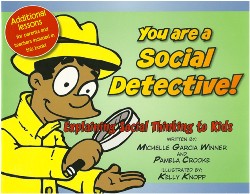 Getting started with the Social Thinking Curriculum by Michelle Garcia Winner is always a challenge. Most of us, Speech-Language Pathologists, fall under two distinct categories: 1) “Read first Therapists” that like to read and study a program until it we can recite it in our sleep before we will begin to implement it on our students, 2) “Try it out first Therapists” that will try to figure out the program while we implement it on our students.
Getting started with the Social Thinking Curriculum by Michelle Garcia Winner is always a challenge. Most of us, Speech-Language Pathologists, fall under two distinct categories: 1) “Read first Therapists” that like to read and study a program until it we can recite it in our sleep before we will begin to implement it on our students, 2) “Try it out first Therapists” that will try to figure out the program while we implement it on our students.
I belong to the former category. I spent months after my first Social Thinking conference buying various books and studying them. After all that extensive reading, I concluded that, “You are a Social Detective!” was arguably one of the best programs to initiate the Social Thinking curriculum. This is possibly also because a majority of my caseload includes pre-school and early elementary students. It uses a comic book form and introduces many of the social thinking vocabulary in a clear and systematic way.
The first section points out how we all have school smarts, sports smarts, Lego smarts, etc. but we also have social smarts. It explains that social smarts means understanding that others have thoughts about us and we have thoughts about others. We use social smarts everywhere.
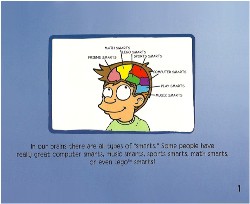
Some of the social thinking vocabulary that is explained using simple but age appropriate illustrations include “being a part of a group,” “thinking with our eyes,” “expected and unexpected behaviors.” The program uses the same social situation to contrast expected and unexpected behaviors, making it easier for children to grasp the concept.
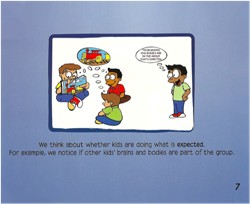 Versus
Versus 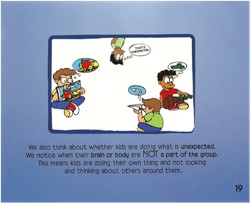
The book introduces the concept of “having uncomfortable thoughts,” which, in my opinion is more appropriate and specific than using “feeling mad or angry,” especially for children on the spectrum. Feeling angry is so broad and vague and encompasses so many different scenarios and situations, that it makes it challenging for children on the Autism Spectrum. “Having uncomfortable thoughts” directly links the person’s thoughts to the student’s behavior.
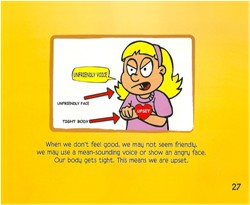 The book also explains “being upset” in explicit physical terms (mean sounding voice, angry face, body gets tight) so children can identify their own states when they get upset.
The book also explains “being upset” in explicit physical terms (mean sounding voice, angry face, body gets tight) so children can identify their own states when they get upset.
The book then goes on to explain the process of being a social detective, i.e. using eyes and ears along with what they know in their brains. The authors talk about how we use our eyes, ears and brain to make “Smart Guesses” about how to behave. The contrast (Whacky Guess) is also illustrated.
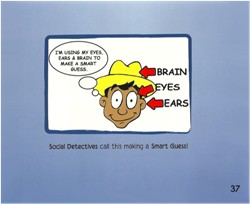 Another challenge a lot of my little ones have is identifying and differentiating between peers who are nice and friendly and others who say or do mean things. The book has tables (page 44 and 45) to help the child identify and list characteristics of a “nice person” and a person who is “not nice to talk to.” In addition, the book also has a glossary with definitions of the Social Thinking vocabulary for quick reference. The book also includes three lesson plans at the end of the book for “Expected Vs Unexpected Behaviors,” “Social Spy,” and “Social Detective.”
Another challenge a lot of my little ones have is identifying and differentiating between peers who are nice and friendly and others who say or do mean things. The book has tables (page 44 and 45) to help the child identify and list characteristics of a “nice person” and a person who is “not nice to talk to.” In addition, the book also has a glossary with definitions of the Social Thinking vocabulary for quick reference. The book also includes three lesson plans at the end of the book for “Expected Vs Unexpected Behaviors,” “Social Spy,” and “Social Detective.”
Pros:
- Illustrates in a simple and clear manner what it means to be a social detective.
- Appropriate for early to late elementary aged students.
- Contains three lesson plans that require little to no preparation.
Cons:
- The illustrations may not be appropriate for older students.
- Wish it included more lesson plans.
- Some of the concepts may be challenging for low functioning students.
For me, “Being a Social Detective” forms the crux of the Social Thinking curriculum. Unless our students understand that their “unexpected behaviors” cause others to have “uncomfortable thoughts” about them, they are unlikely to change their behaviors. Concrete reinforcers such as prizes will only go so far.
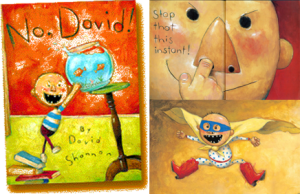 Putting a lesson together to teach the concept of “expected/ unexpected behaviors” using “No David!” would be fairly easy for most experienced clinicians. However, for me, having the resource list of children’s books that teach specific Social Thinking concepts makes Audra Jensen’s book an incredibly handy tool. An additional benefit of using children’s literature as a tool is that lessons can be planned for individual (one-on-one sessions) as well as groups.
Putting a lesson together to teach the concept of “expected/ unexpected behaviors” using “No David!” would be fairly easy for most experienced clinicians. However, for me, having the resource list of children’s books that teach specific Social Thinking concepts makes Audra Jensen’s book an incredibly handy tool. An additional benefit of using children’s literature as a tool is that lessons can be planned for individual (one-on-one sessions) as well as groups.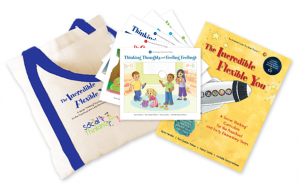 The area of language disorders that seemed to confound most therapists, including myself, for a long time was social skills or pragmatics. That was until I discovered Michelle Garcia Winner’s work. When I read her book “Thinking About YOU, Thinking About ME,” I finally felt relief. I started thinking about social skills in a completely different way that made sense. I realized that the reason my therapy tools didn’t seem powerful or effective was because I was focusing on teaching specific skills (e.g. How to start a conversation) in a specific situation (e.g. When you meet your neighbor), rather than teaching social thinking or social cognition. As a clinician, when you teach a specific skill in an artificial environment, the student may do well to learn the skill. But the questions “What happens when the situation changes? Can my student generalize this skill to another environment?” always haunted me. The knowledge that you can build a child’s perspective taking ability, or his ability to “listen with his whole body” to help him across situations and contexts, was my Eureka moment.
The area of language disorders that seemed to confound most therapists, including myself, for a long time was social skills or pragmatics. That was until I discovered Michelle Garcia Winner’s work. When I read her book “Thinking About YOU, Thinking About ME,” I finally felt relief. I started thinking about social skills in a completely different way that made sense. I realized that the reason my therapy tools didn’t seem powerful or effective was because I was focusing on teaching specific skills (e.g. How to start a conversation) in a specific situation (e.g. When you meet your neighbor), rather than teaching social thinking or social cognition. As a clinician, when you teach a specific skill in an artificial environment, the student may do well to learn the skill. But the questions “What happens when the situation changes? Can my student generalize this skill to another environment?” always haunted me. The knowledge that you can build a child’s perspective taking ability, or his ability to “listen with his whole body” to help him across situations and contexts, was my Eureka moment.